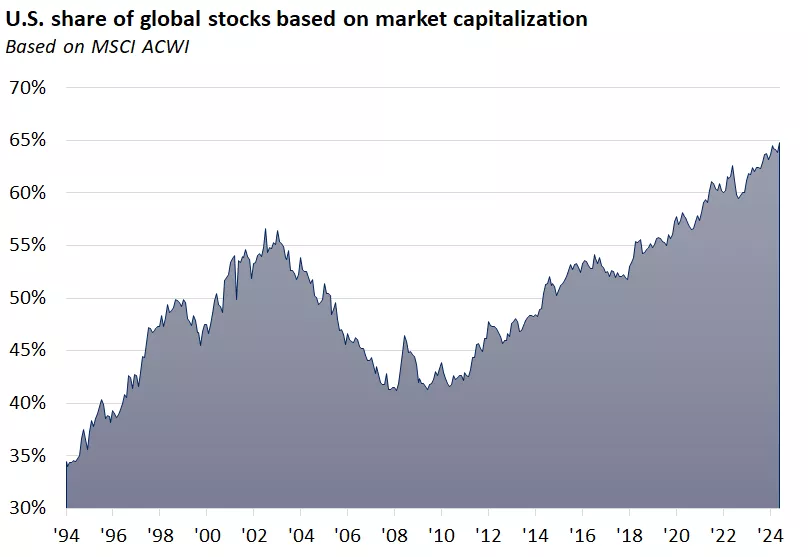Monthly international market focus
How could a Trump administration impact international markets?
What you need to know
- Though any sizable impact may not be felt until 2026, tariff and trade uncertainties could weigh on international stocks.
- Pro-growth policies and wider U.S. deficits have the potential to boost U.S. economic growth. However, they could also drive inflation, which may lead the Federal Reserve to keep interest rates higher than it otherwise would. A slower pace of easing by the Fed than that of other central banks would support a strong U.S. dollar.
- We find long-term value in international stocks, but trade uncertainty and currency headwinds keep us cautious in the near term. We recommend underweighting international developed equities and maintaining a neutral allocation in emerging-market equities.
Potential tariffs introduce uncertainty that could dampen international sentiment
The decisive result of the November U.S. elections has led markets to begin pricing in potential policies that might follow. For international economies and markets, the biggest question is how U.S. trade policy will affect the outlook for growth and inflation, since a key part of President-elect Donald Trump’s campaign pledges has focused on imposing broad tariffs (10%–20% on all imports and 60% on imports from China).
Exports of countries with a large trade deficit with the U.S. — such as China, Vietnam, Mexico, Germany and Japan — might be reduced, as tariffs will make their products pricier. While currency depreciation might partially offset these costs, trade disruption could also lead foreign firms to slow investment and hiring, weighing on economic growth. During the 2018–2019 trade war, eurozone and China gross domestic product (GDP) slowed notably.
We expect the new administration to take a targeted approach to tariffs, at least initially. In the scenario of universal tariffs, by the time any policies are passed and implemented, any potential impact may not be felt until 2026. Nonetheless, the looming trade uncertainty may weigh on sentiment and valuations of international equity markets next year.

This chart shows average U.S. import tariffs from 1945 to 2023.

This chart shows average U.S. import tariffs from 1945 to 2023.
Central bank divergence could drive further U.S. dollar strength
Following the election, the U.S. dollar recorded its biggest one-day rally in two years and is currently at a one-year high against major currencies. U.S. tax cuts may boost growth, while new tariffs could be inflationary, prompting the Fed to keep rates higher than it otherwise would. This is now reflected in the bond market, which is pricing in a shallower rate-cutting cycle, projecting three additional rate cuts expected by the end of 2025 instead of about six expected a month ago.
On the other hand, the threat of slowing exports may prompt other central banks to cut rates more aggressively. This possible economic growth and central -bank divergence may impact bond-yield differentials, supporting a stronger U.S. dollar. Historically, international equities tend to underperform during periods of a strengthening dollar.

This chart shows the average 12-month performance of U.S. versus international and emerging-market stocks during months of a stronger and weaker U.S. dollar.

This chart shows the average 12-month performance of U.S. versus international and emerging-market stocks during months of a stronger and weaker U.S. dollar.
U.S. exceptionalism likely to continue in 2025
The stronger U.S. economic and earnings growth relative to most other advanced economies is reinforcing the increasing share of U.S. stocks in global equity markets. As of November 2024, U.S. stocks account for a record 65% of global market capitalization, and the new administration’s policy proposals may further solidify this dominance.
While deep discounts and attractive dividend yields offer long-term value, tariff uncertainty and a potentially strong U.S. dollar keep us cautious in the near term. We continue to believe international stocks play an important role in diversifying portfolios, but we recommend underweighting international developed equities and maintaining a neutral allocation to emerging-market equities.

This chart shows the share of the MSCI ACWI Index represented by U.S. companies since 1994.

This chart shows the share of the MSCI ACWI Index represented by U.S. companies since 1994.
Angelo Kourkafas
Angelo Kourkafas is responsible for analyzing market conditions, assessing economic trends and developing portfolio strategies and recommendations that help investors work toward their long-term financial goals.
He is a contributor to Edward Jones Market Insights and has been featured in The Wall Street Journal, CNBC, FORTUNE magazine, Marketwatch, U.S. News & World Report, The Observer and the Financial Post.
Angelo graduated magna cum laude with a bachelor’s degree in business administration from Athens University of Economics and Business in Greece and received an MBA with concentrations in finance and investments from Minnesota State University.
Important information:
Past performance of the markets is not a guarantee of future results.
Investing in equities involves risk. The value of your shares will fluctuate, and you may lose principal. Mid- and small-cap stocks tend to be more volatile than large-company stocks. Special risks are involved in international and emerging-market investing, including those related to currency fluctuations and foreign political and economic events.
Diversification does not ensure a profit or protect against loss in a declining market.
